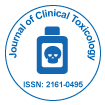
Journal of Clinical Toxicology
Open Access
ISSN: 2161-0495

ISSN: 2161-0495
F Balszuweit , John H, Schmidt A, Kehe K, Thiermann H and Steinritz D
Scientific Tracks Abstracts: J Clin Toxicol
Sulfur mustard (SM) is a vesicating chemical warfare agent causing skin blistering, ulceration, impaired wound healing, prolonged
hospitalization and permanent lesions. Silibinin, the lead compound from Silybum marianum, has been discussed as a potential
antidote to SM poisoning, but previous investigations had been limited to nitrogen mustards. Water solubility of silibinin is poor, thus
a water-soluble prodrug, e.g. silibinin-bis-succinat (silibinin-BS, SIL-BS) should be desirable for rapid bioavailability as an antidote.
HaCaT cells were exposed to SM (30, 100, and 300 μM) for 30 min and treated thereafter with SIL-BS (10, 50, and 100 μM) for 24 h.
Necrosis, apoptosis and production interleukin-6 and -8 were determined. SIL-BS dose-dependently reduced SM cytotoxicity, even
after 300 μM exposure. Doses of 50-100 μM SIL-BS were required for significant protection. Apoptosis and interleukin production
remained largely unchanged by 10-50 μM SIL-BS but increased slightly after 100 μM treatment, in particular when cells had previously
been exposed to 300 μM SM. HaCaT cells, incubated with SIL-BS were lysed and investigated by LC-ESI MS/MS. Findings suggest
that SIL-BS is absorbed by HaCaT cells and biotransformed into free silibinin. In summary, silibinin-BS is a promising compound for
the treatment of SM injuries: biotransformation to free silibinin is possible and standard doses for clinical use (50-100 μM) provided
a significant reduction of necrosis. At doses of 50 μM SIL-BS, no pro-inflammatory or pro-apoptotic effects occurred, but even proapoptotic
effects of 100 μM SIL-BS were observed only after 300 μM SM exposure and might even be useful to eliminate cells with
irreversible SM-induced damage.
F Balszuweit is a pharmacist and obtained his PhD at the Free University Berlin in 2005. Along with his research activities within the Bundeswehr Medical Service, he has
been concerned with research management, regulatory affairs and scientific cooperation. His research interests are focused on cell co-cultures to identify novel treatment
strategies, in particular against sulfur mustard injuries.